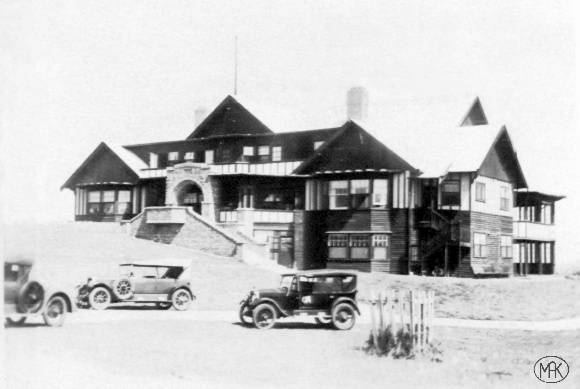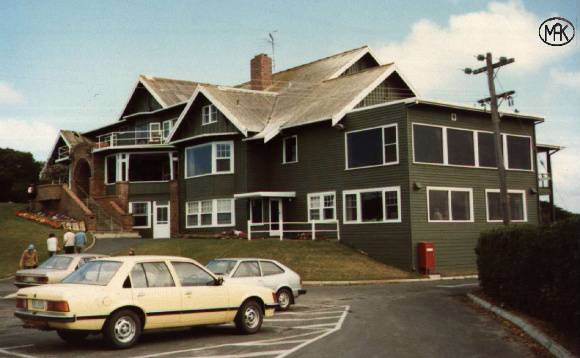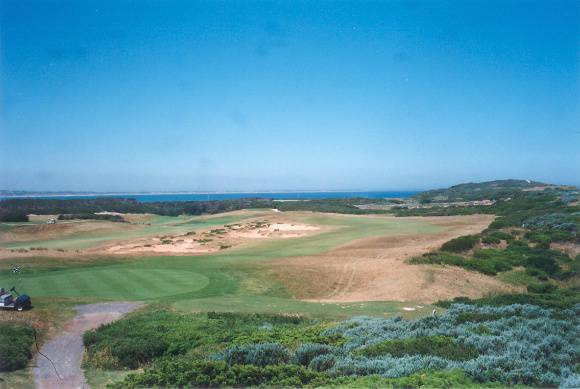| Back to search results » | Back to search page » |
|
Barwon Heads Golf Club House & Golf Course
LocationGolf Links Road, BARWON HEADS VIC 3227 - Property No B7368
File NumberB7368LevelState |
|
Statement of Significance
What is significant? The Barwon Heads Golf Clubhouse, designed by the Melbourne architects Klingender and Hamilton and built in 1923-24, is situated on undulating coastal land on the Bellarine Peninsula south of the town of Barwon Heads and looking out over Bass Strait.
The building is clad in horizontal and vertical weatherboard, now painted in a uniform pale green but originally designed to simulate a half timbered style. It has a dominant gable roof which traverses the site and has projecting gables with wide overhanging eaves. It is asymmetrical and eclectic in design and detailing and owes much to the influence of the Arts and Crafts style popular with its architects. Original design features include; the parapeted and arched tapestry brick entrance porch; brick chimneys; the flat roofed verandah porch with balcony above and the flat roofed two-storey bay windows in the projecting gables. These and other windows are double hung with their original timber frames and six and eight paned upper lights. Also original are the timber and glazed entrance and balcony doors, and the timber verandah columns supported by unpainted brick piers with projecting capping.
The roof, originally of lapped corrugated fibro cement sheet, was replaced in 1969 but retains the integrity of the building. Other extension and renovation work carried out more recently by the architects McGlashen and Everest and builders Wycombe Construction has been done sympathetically to the original structure.
The unique golf course, influenced by the design of Scottish links courses, is characterised by its natural and semi-natural undulating terrain with its rolling greens and sandy hillocks. The manicured greens and fairways are covered in native and exotic grasses, with strategically placed and substantial cypress trees forming wind buffers, screens and visual foci within the course landscape. The course was originally constructed in 1920 but was extended in 1960 by the addition of a 9 hole Par 3 course to the north west of the clubhouse.
How is it significant? The Barwon Heads Golf Clubhouse and Golf Course is significant for aesthetic/architectural, historic and social reasons at a State level.
Why is it significant? The Barwon Heads Clubhouse is aesthetically and architecturally significant as demonstrating the design features considered appropriate for a major sports facility in the interwar years. Designed by the architects Klingender and Hamilton under the supervision of Laird and Buchan, it harmoniously combines many of the attractive visual elements which were popular prior to and during the 1920s. These features have been carefully retained externally and in some interior rooms in spite of extension and upgrading of facilities. By the late 1920s Robert Hamilton was considered the foremost exponent of Tudor Revival style in Melbourne. He was responsible for many of the buildings in Toorak Village and also for the heritage listed Denby Dale flats in Kooyong (1937).
The Barwon Heads Clubhouse is historically and socially significant for its associations with the development of the Barwon Heads golf course of a links design, the first established course of this type in Australia. Historically it was the first clubhouse with accommodation for both sexes, based upon country club lines in Victoria. The clubhouse is socially significant for its golf and recreational associations and the high value the community has placed upon it since its opening. It continues to operate successfully and provide facilities and accommodation for golfing enthusiasts.
The Barwon Heads links golf course, which opened in 1922, is the only course in Australia of the 1920s and 30s based on the design of coastal golf course architecture in Scotland. Historically it is linked to the world's most famous golf course designer of that time, Dr. Alister Mackenzie, who consulted on its design in 1931. Its distinctive features include the natural and semi-natural undulating terrain; rolling hills, sandy hillocks, manicured greens and fairways covered in native and exotic grass including couch grass. Strategically placed substantial cypress trees form wind buffers, screens and visual foci within the course landscape. Bunkers are situated on the slopes and valleys of natural inclines and the views extend to coastline panoramas beyond to Ocean Grove, Point Lonsdale and the Mornington Peninsula. The course has played host to a number of famous golfing names over the years including Alex Russell, Peter Thomson, Ian Baker-Finch and Brett Ogle.
The Barwon Heads Golf Clubhouse and Course complex is significant for its reflection of the aspirations and values of the 1920/30 period when there was an increasing preoccupation with sporting and outdoor activities as a means of improving community health.
Classified: 01/06/2009
Group
Recreation and Entertainment
Category
Golf Course






